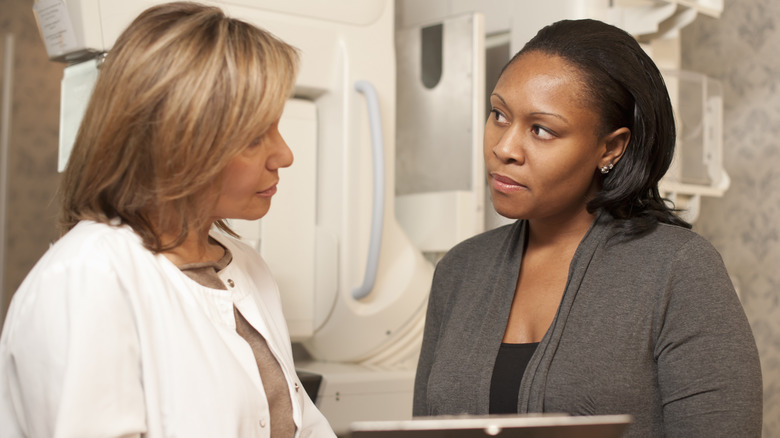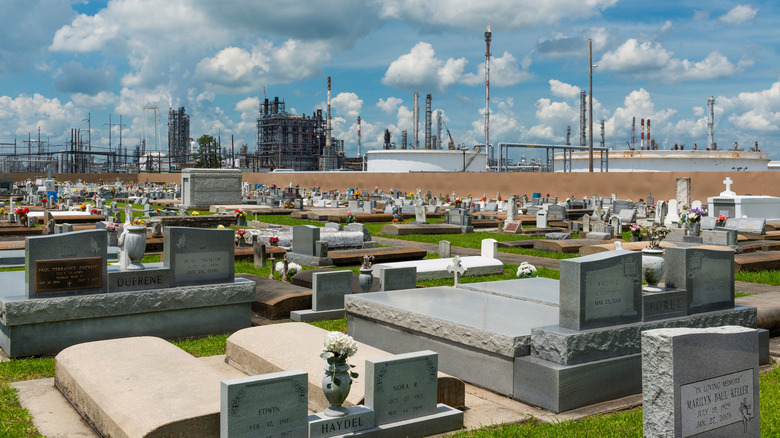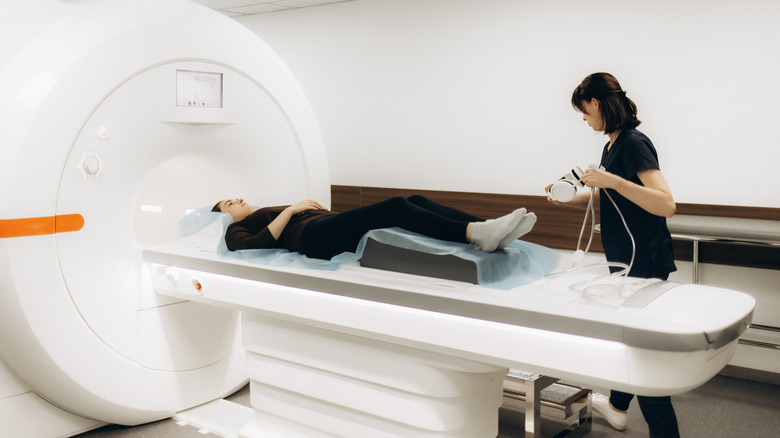You're More Likely To Die From Cancer If You Live In These 10 States
Cancer is one of the leading causes of death in the United States, with over two million new cases reported in 2024 alone. There are many factors that play a role in the development of the insidious disease, from heredity to lifestyle choices like diet, exercise, and smoking. Each of these affects overall health, and they can largely dictate a person's future health outlook. However, did you know that where you live might also hold a clue?
According to the National Cancer Institute, cancer rates vary dramatically across the United States, with certain areas experiencing significantly higher rates than others. What is to account for the disparity? There are several culprits that could be to blame, including basic access to healthcare and exposure to environmental stressors like air pollution and chemicals. Some states have very specific industries that increase the likelihood of exposure to certain carcinogens, while others might have populations that struggle to get the preventative care necessary for early detection.
Regional lifestyles like diet and exercise habits, as well as socioeconomic status, can also play important roles in cancer outcomes. While cancer naturally occurs in all states, there are at least 10 where those diagnosed are more likely to die from the disease. It's important to note that some states may have lower cancer incidence rates compared to others, but face higher mortality rates — a reflection of the challenges that residents in many of these states face in getting the quality care needed.
Kentucky has the highest cancer mortality rate in the US
Kentucky leads the list for cancer mortality rates. The sobering statistic is driven by several factors, including a smoking rate that exceeds the national average and that contributes to residents dying from the disease at least 50% more than people in other states. In addition to lung cancer, Kentucky also ranks in the top 10 for deaths caused by colorectal, breast, and cervical cancers.
Obesity, which is another risk factor closely tied to many types of cancer, affects some 36% of men and over 32% of women in the state. Coupled with fewer routine cancer screenings, many cases in Kentucky go undetected until later stages when treatment becomes less effective. The delay in diagnosis is a critical point, contributing to the state's high mortality rate — despite advanced treatment options being available for many cancers. Even Kentucky's healthcare infrastructure faces challenges, as not everyone has equal access to the care they need. People in rural areas in particular may struggle with limited resources, making it difficult to travel longer distances to healthcare facilities.
Adding to the problem are environmental and occupational exposures. According to 2011 research published in Public Health Reports, the state's robust mining industry has been linked to elevated exposure to carcinogens, further increasing lung cancer rates in southeastern Kentucky. Despite these many challenges, local initiatives like the University of Kentucky Marley Cancer Center aim to address some of the disparities by improving access to screenings and educating communities about prevention.
Cancers of the breast, lung, prostate, and skin are common in Iowa
Lung cancer is a leading cause of death in Iowa, along with elevated incidences of breast, skin, and prostate cancers. Smoking rates in the state, along with exposure to both chemicals and agricultural pesticides, are also key factors. Because the state's agricultural industry is so vast, residents are more routinely exposed to toxic substances that could increase the chances of developing certain types of cancer (including melanoma and prostate cancer).
Breast cancer is another major concern, with the state consistently ranking near the top for cases. The disease's prevalence is largely affected by lifestyle factors like obesity and alcohol intake, both of which are linked to an increased risk of developing breast cancer. In fact, research shows that Iowa's high rate of alcohol consumption, along with other health behaviors, increases the likelihood of receiving a cancer diagnosis. "Alcohol is one modifiable risk where Iowans stand out from the rest of the country, and that may be contributing to our high cancer rates," Mary Charlton, a director of the Iowa Cancer Registry at the University of Iowa, told The Gazette.
Despite these challenges, ongoing efforts aim to reduce the risks of cancer deaths. The state's health departments stress the importance of education, in particular highlighting the dangers associated with smoking, excessive alcohol use, and exposure to pesticides. There's also an increased push to promote prevention efforts, including early screening methods to improve long-term survival rates.
Louisiana has cancer rates more than 40% higher than other states
With a 40% higher rate than the national average, incidences of cancer in Louisiana are some of the highest in the nation. The statistic is particularly jarring given the state's cancer mortality rates, also significantly higher than most other states. Prostate, lung, colorectal, and breast cancers top the list, per LSU Health New Orleans. High smoking rates, along with harmful environmental exposures, make cancer a leading cause of mortality in the state.
One of the most concerning aspects of this crisis situation is "Cancer Alley," 85 miles of land running along the Mississippi River between Baton Rouge and New Orleans. With its heavy concentration of petrochemical plants, the region has long been linked with higher lung and breast cancer rates (along with other respiratory diseases) due to the toxic emissions from nearby factories. In fact, residents of Cancer Alley are seven times more likely to develop industrial pollution-related cancer than elsewhere in the country.
There's been an increased focus on the inequalities that Black and low-income residents in Louisiana face. Consisting of multiple parishes, Cancer Alley is home to some 45,000 people, all of whom are at increased risk of cancer and mortality. Proximity to formaldehyde, benzene, and ethylene oxide are just a few of the most serious culprits that contribute to the unclean air, driving up the risk.
West Virginians are at greater risk of developing cancer
The statistics for West Virginia are jarring: Approximately one in eight adults have survived cancer, and more than 25% of seniors in the state have had cancer at some point. Factors like smoking, poor diet, and a lack of screenings have all contributed to the increased risk. Smoking remains the leading cause of lung cancer in West Virginia, which has some of the highest rates of tobacco use in the country. This, coupled with significantly limited access to healthcare in more rural areas, has made cancer a major public health concern.
It's equally sobering that West Virginia has the second worst life expectancy rate in the United States. In 2021, the state ranked first in the country among cancer deaths with 184.7 per 100,000 patients, followed by accidents and drug overdoses. A key predicament is access to quality healthcare, something that is difficult for those who live in more rural areas.
Brian Huggins, who is a health officer in Monongalia County, West Virginia, attributes the grim news to a variety of factors, including "political skepticism about health measures" (per West Virginia Watch). He also notes that it isn't common to prioritize health food in the state, and that there aren't many sidewalks to promote taking walks for health. Platforms like the UVA Cancer Center are hoping to enact some changes, opening lung cancer screenings to rural West Virginians in the hopes of earlier, life-saving detection.
Cancer diagnoses have spiked in Arkansas
Cancer is the second leading cause of death in Arkansas, with a host of factors leading to its incidence. Between 2017 and 2020, it led the nation among the states with some of the highest rates of cancer mortality in the country. In early 2024, it was projected that at least 19,100 new cases would be diagnosed in the state, with incidences of lung, breast, prostate, and lung spiking. The latter is of major concern, influenced largely by tobacco smoking, a common habit among Arkansans. The state also has higher-than-average obesity rates, increasing the risk of developing cancer.
In addition to these risk factors, lower levels of physical activity and poor dietary habits also contribute to the increased incidence of cancer. There is a lack of sufficient healthcare access in certain areas of Arkansas, making it difficult for many residents to get timely screenings or seek treatment. Rural parts of the state are particularly affected.
To that point, it's sobering that the five-year survival rate of Arkansans with lung cancer was 19.7% in 2020, a notable difference from the national 22.6% rate (per the American Lung Association). The Arkansas Department of Health reported that between 2005 and 2019, the state had a higher rate of cancer deaths than the entire country, with the rate of colorectal cancer deaths trending higher in the state than the rest of the nation.
Nebraska had higher mortality rates for certain cancers than other states
Nebraska faces some of the highest cancer mortality rates in the nation, particularly esophageal, blood, and kidney cancers among men. Further University of Nebraska Medical Center findings also revealed that Nebraskans are more likely to develop cancer than residents in other states. Among those diagnoses, cancers of the prostate, lung, breast, and rectum were the most common.
Soberingly, pediatric cancer rates in Nebraska have spiked, with the state having one of the highest incidences outside of the northeast, according to the Centers for Disease Control and Prevention (CDC). Brain tumors are among the most diagnosed cancers in Nebraskan children. And tied to this is the fact that the state's mortality rate among pediatric cancer patients is higher than that of other states, with 3.1 deaths per 100,000 compared to 2.4 per 100,000 in the rest of the United States.
While there are several factors that could be identified as culprits, a few Nebraska-specific reasons stand out. In 2023, for example, the University of Nebraska Medical Center highlighted an elevated risk of skin cancer among the state's farmers. Evi Farazi, who was the principal investigator of a study conducted by UNMC, said, "It has been shown that they are at higher risk for certain cancers, for example, for skin cancer since they're outside working in the sun. Also, they're exposed to some chemicals in agricultural production" (per KETV Omaha). Other risk factors identified included poor diets and lack of exercise.
Cancer is the second leading cause of death in New Jersey
New Jersey's statistics are very eye-opening: One in two men will develop cancer, and one in three women will be diagnosed. It's the second leading cause of death in the state, followed only by heart disease. Nearly half of the diagnoses and deaths in the state are cancers of the breast, lung, prostate, or colorectal organs. More specifically, lung cancer claims more lives in New Jersey than any other cancer. It's a pattern that spans all genders and ethnicities, with smoking identified as the primary culprit.
Among women in the state, meanwhile, breast cancer ranks as the second deadliest form, with colorectal and prostate cancers ranking second and third among men. As for what accounts for the high rate of lung cancer cases, Zach Jump, a senior director of nationwide epidemiology and statistics research at the American Lung Association (ALA), has some thoughts. "Anytime you see something like this," he tells NorthJersey.com, "it's a lot of the classic culprits: historical inequalities, exposure to tobacco smoke, and air pollution."
Those inequalities especially affect the state's Black population. The ALA's 2024 "State of Lung Cancer" report, in fact, found that white New Jerseyans had a 32.5% five-year survival rate compared to 22.6% among Black residents. Lack of early detection is a key factor, as is inaccessibility to effective treatments.
Lung cancer rates in Maine are especially high
Maine's cancer mortality statistics are concerning. The findings of the 2023 Maine cancer snapshot reveal a significant disparity, as in 2020, the state recorded an age-adjusted cancer mortality rate of 161.3 per 100,000 people, well above the national average of 144.1. Although the overall death rate in the state has continued to fall over the last couple of decades, it still exceeds the national rate.
The most common culprits responsible for cancer-related deaths in Maine include lung and bronchus cancers, along with breast, prostate, and colorectal cancers. The former, in particular, has long been a leading cause of mortality, exacerbated in large part by increased smoking and other environmental factors across the state. Widespread closures of cancer treatment centers also play a significant role, with The Maine Monitor reporting that there are only a few radiation facilities located in the state.
That lack of convenient locations means that, for some patients, the only way to access life-saving treatment is to drive hundreds of miles to the nearest cancer center. Angela Fochesato, who's a director at the Beth C. Wright Cancer Resource Center in Ellsworth, Maine, tells the publication, "You're fighting just to survive to get to your treatment."
Many areas of New York are hotbeds for cancer diagnoses
With rates higher than the national average, New York has seen a sharp rise in cancer diagnoses in recent years, particularly in certain urban areas. Cancer is the state's second leading cause of death after heart disease. The American Cancer Society estimates that in 2024 alone, there will be nearly 123,000 new diagnoses and nearly 31,000 deaths in the state. Staten Island leads New York City in rates for several types of cancer diagnoses, including malignant tumors of the colon, breast, and lung. Syracuse and other parts of upstate New York report troubling cancer clusters, especially tied to environmental pollutants and industrial waste from decades past.
Pollution in particular is often linked to the state's industrial roots, with some areas experiencing a history of carcinogen exposure in air, soil, and water. Densely populated areas also face higher risks due to lifestyle factors like smoking and limited access to green spaces, which could make getting regular exercise difficult and encourage a more sedentary lifestyle. In even more rural areas, access to vital cancer care is a persistent challenge that can delay both diagnosis and treatment.
There have been some strides made in the state health agency's efforts to combat these problems. The Community Cancer Prevention in Action (CPiA) was created by the state's health department to support initiatives throughout the state promoting awareness for prevention and early detection.
Mississippi has the highest breast cancer mortality rate in the country
Approximately one in every five deaths in Mississippi is due to cancer, according to the state's health department. Among all types of cancer, Mississippi's mortality rates are some of the worst in the country. And grimly, the state has the highest breast cancer mortality rate as well. The Mississippi State Department of Health attributes this to a lack of screenings, with over 25% skipping a routine mammogram that could potentially catch the disease early.
Much of the problem can be attributed to widespread poverty and lack of awareness. It's estimated that some 19% of the state's residents live in poverty. Information about screenings is limited in these communities, says Rajesh Balkrishnan, who is a professor of public health at the University of Virginia. He tells KFF Health News, "There's a big difference in the quality of care."
Along with that is the fact that most of the state's population lives in a rural area, making it very difficult to access everything from general practitioners to cancer treatment centers. And in low-income communities, it's simply not easy or cost-effective to make health care the priority that it should be. OB-GYN Mildred Ridgway of the University of Mississippi Medical Center told KFF Health News, "Women who work and take care of children often have a huge burden of responsibility. They don't have time or the money."











